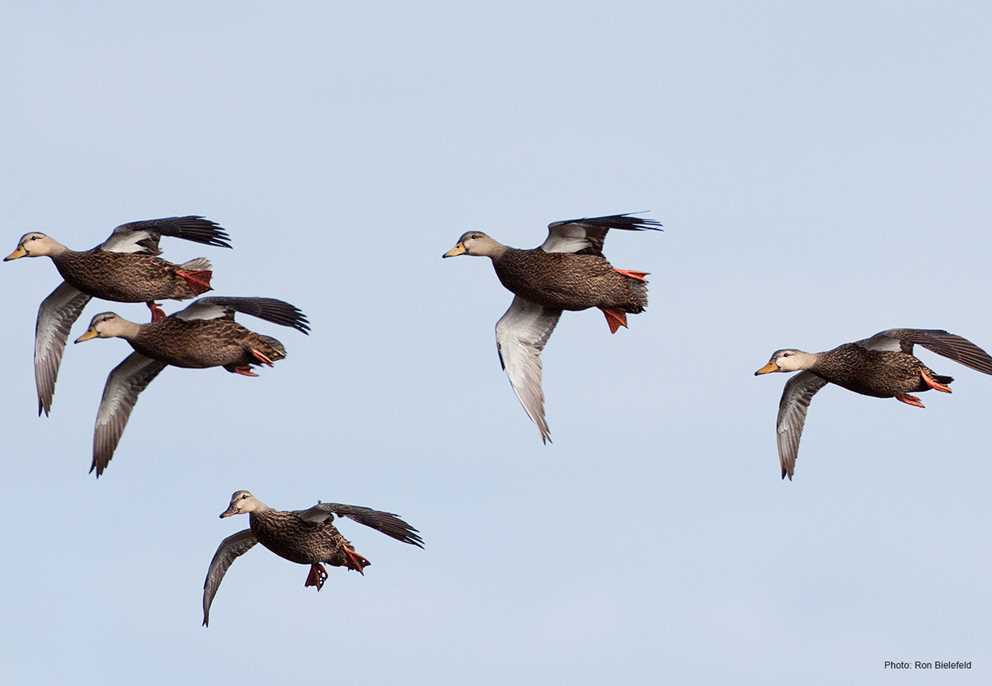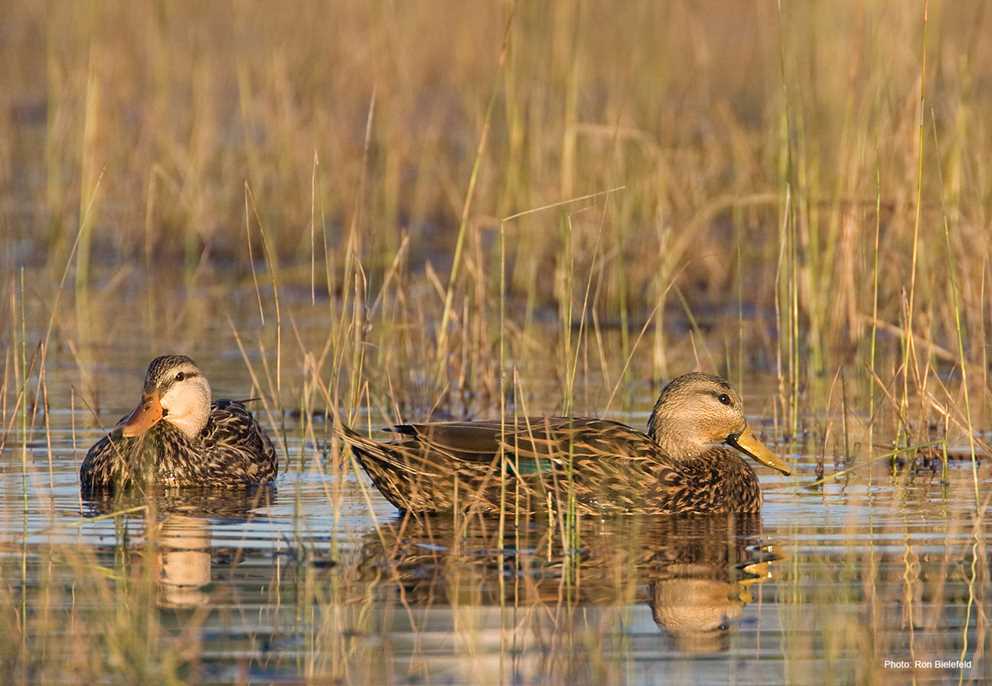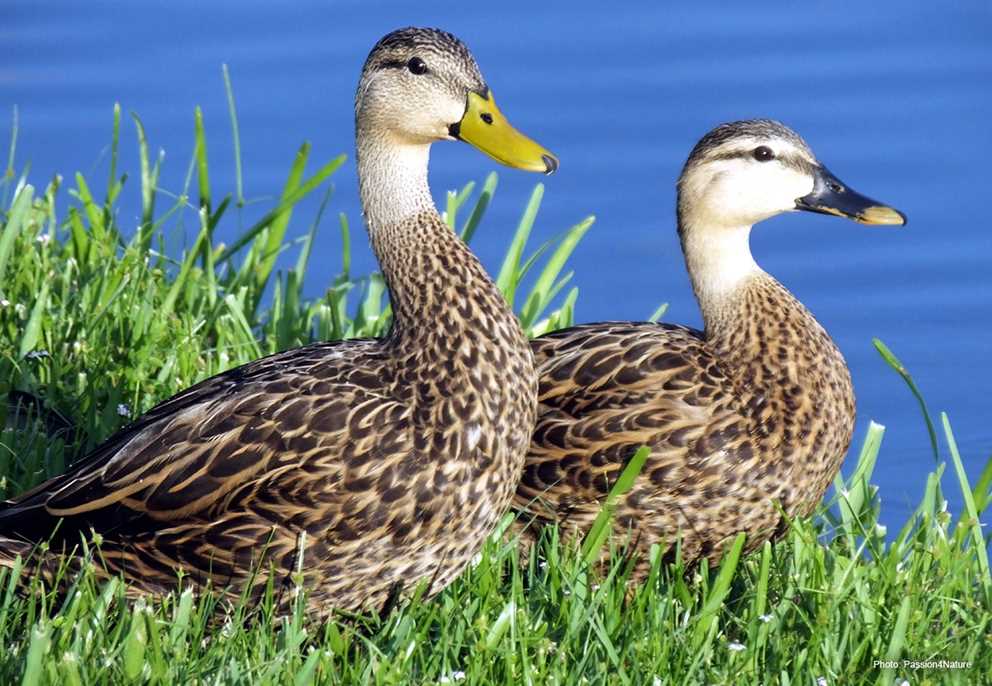Overview
The Mottled Duck is a dabbling duck geographically restricted to two populations in North America. The Western Gulf Coast population (A. f. maculosa) ranges from northern Vera Cruz, Mexico north and east to Mobile Bay. The Florida population (A. f. fulvigula) is found in peninsular Florida. Mottled Ducks were introduced and have become established in coastal Georgia and South Carolina.
Western Gulf Coast Mottled Ducks use fresh and brackish coastal marshes as well as inland agricultural wetlands associated with rice or crawfish production. Florid Mottled Ducks primarily use interior freshwater wetlands, though some use coastal fresh and brackish wetlands.
Recent molecular studies indicate Mottled Ducks are most closely related to Mexican Ducks, and those two species are more closely related to American Black Ducks than Mallards.
Male and female Mottled Ducks are similar in appearance, though females are slightly lighter because of wider buffy brown edges on contour feathers. The head is tan to buffy, with variable faint dark streaks, a dark brown crown, and dark brown eye stripes. The throat of Mottled Ducks is unmarked and buffy, which serves as a subtle but useful feature for distinguishing them from American Black Ducks and Mexican Ducks. The speculum is bluish-green and has a black leading edge often without traces of white. Sexes can be separated by bill color, with males having a plain olive to yellow bill, and females having an orange to olive bill with variable black spots or saddle. Both sexes have a dark spot at the gape of the bill, which serves as another useful identifying feature.
Description
Key Identification Features
- Male and female Mottled Ducks are similar in appearance, though females may appear slightly lighter resulting from wider buff margins of contour feathers. Mottled Ducks are much darker than female Mallards, slightly darker than Mexican Ducks, but noticeably lighter than American Black Ducks. The chin and throat are buff and usually lack dark streaking, which can help separate them from similar species.
- The sexes can be separated by bill color, with males having a plain olive-green bill, and females having an orange to olive bill with variable black spots or saddle. Both sexes have a dark spot at the gape of the bill, which is another useful identifying feature. The legs and feet of both sexes are orange to dull orange.
Male/Female Average Length and Weight
- Mass: Males 1.8–2.7 lbs.; Females 1.5–2.5 lbs..
- Wing Length: Male 10.2–10.3 in.; Female 9.6–9.8 in.
Male Identification
- Alternate (Breeding) Plumage: Males are brown with buffy edging on contour feathers, resulting in their namesake mottled appearance. Florida Mottled Ducks tend to be lighter overall than Western Gulf Coast Mottled Ducks. The head is buffy with a dark crown and variable light streaks and a brown eye stripe. The throat is uniformly buff and lacks streaks. The bill is olive to yellow with a black nail and distinct black spot at the gape, and the feet are bright orange.
- Basic Plumage: Overall deep brown; sexes are somewhat similar.
Female Identification
- Alternate and Basic Plumage: Similar to males but lighter overall . Head is similar to males, but the bill is orange to olive with variable dark saddles or spots, and a black spot at the gape. The legs and feet are dull orange.
In-flight Identification
- In flight they have silvery-white wing linings that contrast with dark upper wing The speculum is bluish-green but may appear blue to purple depending on the angle of light and has a black leading edge, and lacks a thin white trailing edge.
Vocalizations
- Male: Makes a very reedy “raeb” similar to that of Mallards.
- Female: Makes a loud “quack,” or a short series of decrescendo “quacks,” also similar to Mallards.
Similar Species
- Mottled Ducks have superficial resemblance to Mexican Ducks, American Black Ducks, and female Mallards. Range is useful but not 100% reliable for separating the species. Mottled Ducks hybridize with Mexican Ducks and Mallards, making identification of some birds difficult.
- Mexican Ducks: Mottled Ducks are somewhat darker than Mexican Ducks and have a bluish-green speculum with a black trailing edge lacking a white border.
- Female Mallards and Mexican Ducks have a bluish speculum with leading and trailing white edging and usually are not as dark as Mottled Ducks.
- American Black Ducks: American Black Ducks have a bluish-purple speculum with black leading and trailing edges, often lacking traces of white. . The black spot at the gape of the bill common in Mottled Ducks is absent in Mallards, American Black Ducks, and Mexican Ducks.
Habitat Preferences
- Florida Mottled Ducks prefer inland freshwater wetlands, though they may be found in fresh and brackish coastal wetlands as well. Western Gulf Coast Mottled Ducks make extensive use of fresh and brackish coastal marshes, inland freshwater wetlands, flooded pastures, and agricultural wetlands associated with rice and crawfish production.
Foraging Habits and Diet
- Mottled Ducks are omnivorous feeders but have a preference for seeds of emergent and aquatic wetland plants. They also eat a variety of aquatic insects, crustaceans, and mollusks.
Breeding Habits
- Monogamy: Mottled Ducks are seasonally monogamous Pair bonding begins in September and October, with nearly all females paired by November or December.
- Nest Location: Mottled Ducks nest from March to June, and intensity of nesting effort related to precipitation and wetland conditions. Mottled Ducks nest in coastal and inland grasslands pastures, and rice fields. Typically breeding at 1 year of age.
- Clutch Size: Averages 8 to12 eggs. The eggs are dull white to pale olive, elliptical, and are 2.2–1.7 in. . The incubation period averages 26 days. Renesting has been documented when nest is lost during laying or early incubation.
Migration & Distribution
- Mottled Ducks are sedentary but some make movements up to 260 miles.

Conservation Status
- Population Status: Contemporary data for Florida Mottled Duck population is lacking. Estimates from the most recent 2008 survey indicated 42,000 birds in the breeding population. Surveys were discontinued thereafter because of difficulty differentiating Mottled Ducks from hybrids during population surveys. Florida population believed to be stable. Breeding population of Western Gulf Coast Mottled Ducks averaged 123,880 from 2011 to 2023, ranging 60,440 to 164,745. Population surveys indicate a long-term decline across the range in Texas and Louisiana. South Carolina and Georgia populations believed to be approximately 40,000.
- Conservation Concerns: Wetland and grassland loss due to urbanization, coastal erosion, saltwater intrusion, channelization, and drainage are challenges to Mottled Duck populations throughout its range. In Florida especially, hybridization with feral Mallards is likely their greatest threat.
- Conservation Focus: Wetland protection and restoration are top priority as well as preventing further genetic introgression in Florida by prohibiting the release of feral Mallards and managing birds already released.
Harvest Information
- An average of 23,590 Mottled Ducks were harvested per season across the US during the 2019 through 2022 hunting seasons.
- Mottled Duck harvest is highest in the Atlantic and Mississippi Flyways, each accounting for about 40 percent of total US harvest; the Central Flyway accounts for the remaining 20 percent.
- The top three states for Mottled Duck harvest, based on annual averages across the 2019–2022 hunting seasons, were Florida (9,099), Louisiana (8,522), and Texas (4,489).



